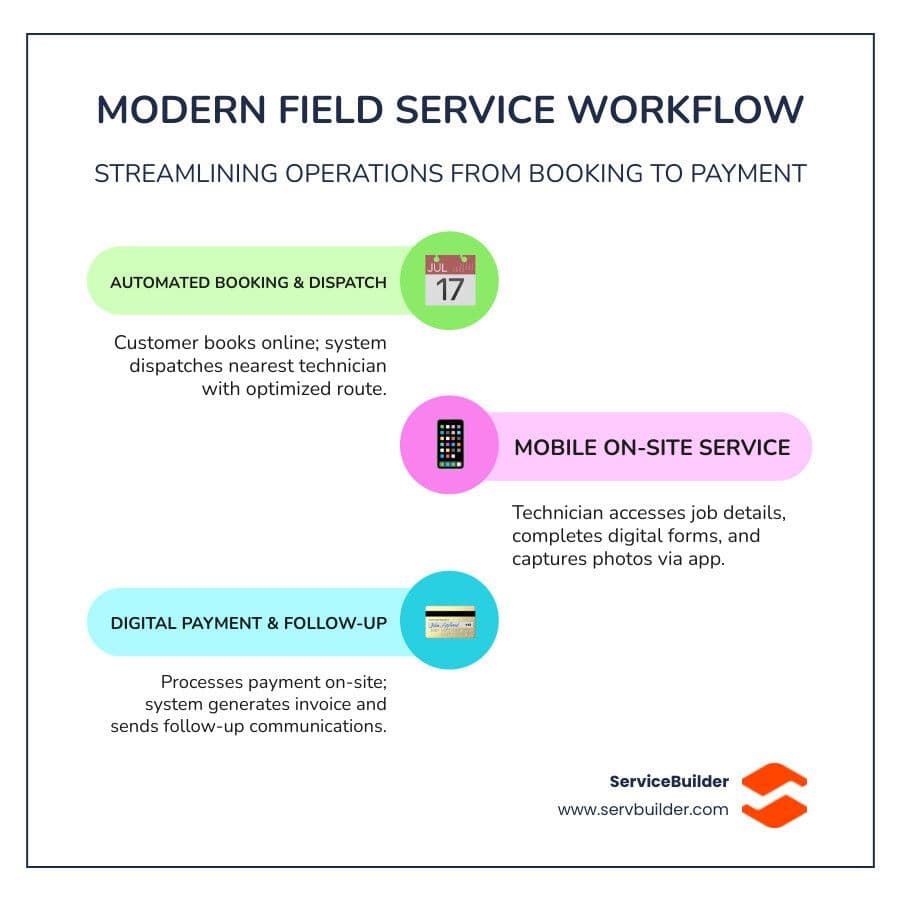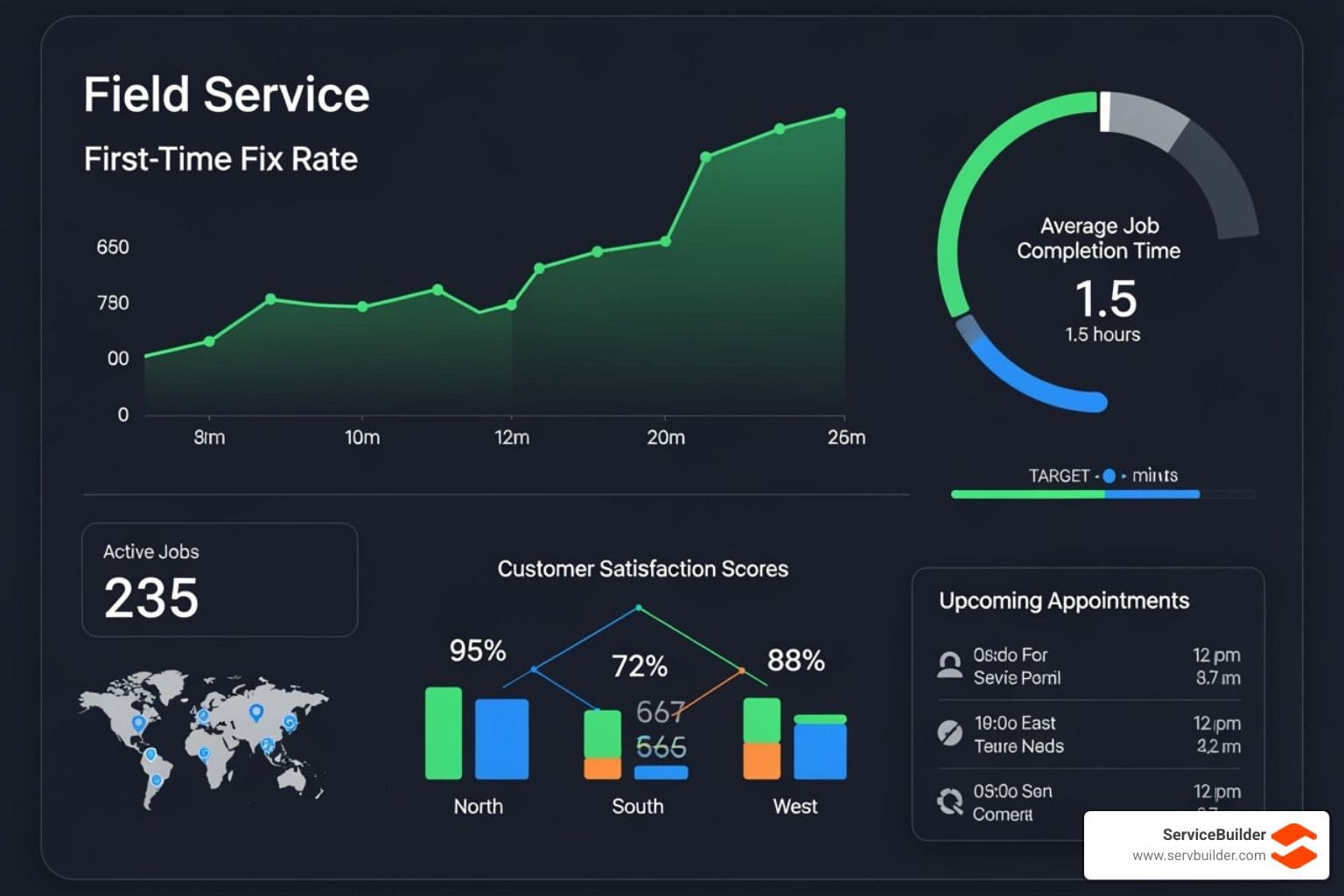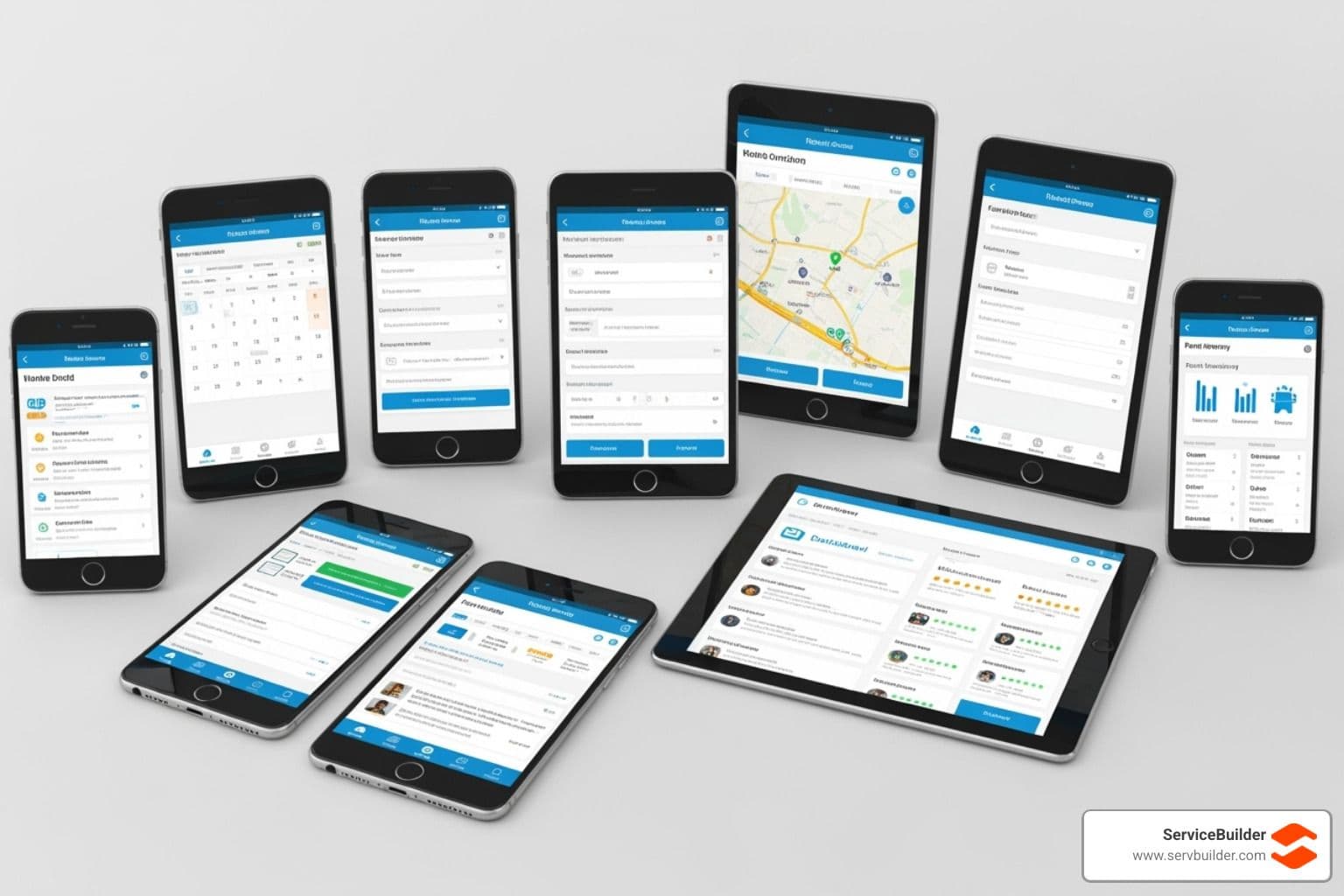The Definitive Guide to Comparing Field Operations Tools
- Andrew Leger
Why Field Operations Management Tools Are Essential for Modern Service Businesses¶
Field operations management tools are software platforms that help service businesses coordinate teams, schedule jobs, and track work in real-time. They replace manual processes like paper schedules and phone calls with digital workflows that connect field workers, dispatchers, and customers.
Key capabilities include:
Automated scheduling and dispatch with smart routing
Mobile access to job details, customer info, and forms
Real-time GPS tracking and live job status updates
Digital workflows with mobile checklists and photo capture
Customer management with automated communications and online payments
Business insights through performance dashboards
Managing a field service team involves daily challenges like scheduling conflicts, inventory issues, and communication breakdowns. Whether you run an HVAC, landscaping, cleaning, or pest control business, these problems are universal. Poor coordination leads to missed appointments, unhappy customers, and wasted fuel. Manual scheduling creates conflicts and leaves gaps in coverage.
Modern field operations management tools solve these issues by streamlining everything from customer contact to final payment. They empower field workers with information on their phones and give managers real-time visibility into operations.
I'm Andrew Leger, and after 15 years in the industry, I saw countless businesses struggle with outdated software. I founded ServiceBuilder to create a modern, mobile-first platform designed for small-to-midsize field service companies.

Find more about field operations management tools:
business operations management tools
operations management and supply chain management
What are Field Operations Management Tools? Core Components & Benefits¶
Think of field operations management tools as the digital command center for your mobile workforce. These platforms transform chaotic phone calls and paper schedules into smooth, streamlined operations, delivering significant efficiency gains and cost reduction. For example, companies have saved millions by digitizing field data and dramatically improved inspection efficiency with mobile apps. For a neutral overview of the discipline and its history, see Field service management.
At its core, effective Field Service Management (FSM) Software handles everything outside your office. Key components include:
Scheduling & Dispatch: The brain of the operation, ensuring the right tech gets to the right job with intelligent routing.
Mobile Accessibility: Robust mobile apps that work offline, giving techs access to job details, photo capture, and office communication.
Work Order Management: Tracks every job from creation to completion, including tasks, materials, and notes.
Invoicing & Payments: Streamlines finances by generating invoices, accepting on-site payments, and integrating with accounting software.
Reporting & Analytics: Provides dashboards to spot bottlenecks, track performance, and identify growth opportunities.
These components directly boost customer satisfaction by enabling accurate arrival times and efficient job completion.
Choosing integrated solutions vs standalone tools is critical. Modern Operations Management Tools unify these features, improving data accuracy and enabling data-driven decisions. When field data flows into one system, like the seamless connection between Microsoft Dynamics 365 Field Service and its financial modules, you eliminate data silos. This turns scattered processes into a well-oiled machine.

Key Features to Look For in Top Field Operations Management Tools¶
When choosing field operations management tools, look for platforms that are reliable and easy to use. The best options share key characteristics: mobile-first design, real-time updates, customization options, scalability, and a great user experience to ensure team adoption.

Essential Scheduling, Dispatching, and Routing Features¶
This is where these tools prove their worth. A quality Service Scheduling App should have:
Automated & AI-assisted dispatch: Intelligently assign jobs based on skills, location, and availability. Platforms like Microsoft Dynamics 365 Field Service use AI to adjust schedules automatically.
Drag-and-drop calendars: Allow dispatchers to make quick manual adjustments.
Real-time GPS tracking & route optimization: Find the nearest technician for emergency calls and calculate the most efficient routes to save fuel, a key feature in apps like Jobber.
Geofencing: Automatically confirm when technicians arrive at and leave job sites.
A powerful Dispatch and Routing App combines these features to streamline your entire dispatch process.
Empowering Technicians with Mobile Accessibility¶
A technician's mobile app is their most important tool. Key features for a Field Service Management App with Scheduling include:
Offline connectivity: Technicians in areas with poor service can still access job info, fill out forms, and take photos. The app syncs automatically when a connection is restored. This is a core feature in platforms like Planado and Fieldman.
Digital forms & checklists: Replace paper forms for consistent data capture.
Access to job history: Helps techs provide better service and avoid repeat questions.
In-app communication, photo attachments & signature capture: Streamline documentation, provide proof of work, and improve first-time fix rates. User-friendly mobile tools like Connecteam excel here.
Streamlining Client and Business Management¶
Top tools manage your entire business, not just fieldwork. A solid Field Service CRM System organizes all customer data in one place. Look for:
Automated quoting, estimates, and digital invoicing: Respond to leads faster and get paid sooner. Jobber users, for example, report getting paid four times faster.
Online payment processing: Offers convenience for customers.
Inventory management: Ensures technicians have the right parts, reducing return trips.
Performance dashboards: Provide a clear view of job times, revenue, and customer satisfaction to help you make data-driven decisions.
Good Client Management Software for Small Businesses integrates these features seamlessly.
Comparing the Best Field Operations Management Software¶
There is no universal "best" field operations management tools because every business has unique needs. The right choice depends on your business size, specific industry needs, and budget. A small landscaping company has different requirements than a large HVAC operation.

To find the right fit, take advantage of free trials from providers like Jobber or Connecteam and read user reviews on sites like Capterra and Gartner.
How to Compare Field Operations Management Tools¶
Follow a clear process to cut through the marketing noise:
Assess your current workflows: Identify your biggest pain points, like paper-based tasks or communication delays.
Define your must-have features: Prioritize features that solve your biggest problems, such as offline capability or AI-assisted dispatch.
Consider scalability: Choose a platform that can grow with your business.
Check integration capabilities: Ensure the software works with your existing tools like QuickBooks or other CRMs. Look for native integrations or API access.
Request demos: Ask providers to show you how their software handles your specific, real-world scenarios. Business Operations Management Tools
What Sets ServiceBuilder Apart¶
We built ServiceBuilder for service businesses struggling with software that was too expensive, complex, or not designed for fieldwork. Our platform stands out with:
Mobile-First Design: Built from the ground up for technicians' phones, using a modern tech stack for speed and reliability.
U.S.-Based Support: Get help from our team in Omaha, Nebraska, who understand the challenges of American field service businesses.
AI-Assisted Scheduling & Quoting: Our system learns your business to suggest optimal schedules and generate accurate quotes.
Customizable Workflows & Seamless Integrations: The platform adapts to your processes and connects easily with popular accounting and CRM software.
Transparent Pricing: We deliver real value without the enterprise price tag or hidden fees. Find how ServiceBuilder can streamline your field operations
Overview of the Broader Market¶
The market for field operations management tools is diverse, with options tailored to different business sizes and needs.
Enterprise-Grade Solutions: Platforms like Microsoft Dynamics 365 Field Service, Salesforce Field Service, and IFS offer advanced features like AI, IoT, and robust ERP integration for large corporations.
Industry-Specific Solutions: Tools like Aimsio (construction, oil & gas) and Fieldman (utilities) cater to specialized niches with custom features.
Small & Medium Business (SMB) Platforms: This is the most competitive segment. Here’s a closer look at a few leaders:
Jobber: A dominant player in the home services space (HVAC, cleaning, landscaping). It's known for its user-friendly interface and a seamless workflow from quoting to invoicing and payment. Its strength is its focus on the core needs of small service businesses.
Housecall Pro: Another major competitor to Jobber, also focused on home services. It stands out with strong marketing features, like automated email and postcard campaigns, and offers consumer financing options to help close bigger jobs.
Connecteam: Positioned as an all-in-one employee management app for various deskless industries. Its core strengths are internal communication and time tracking. While it can manage field tasks, it may not have the deep, industry-specific job management features that dedicated FSM platforms offer.
Budget-Conscious Options: For new or very small businesses, tools like ServiceM8 provide free or low-cost entry points to digitize basic operations.
While these competitors offer valuable features, ServiceBuilder focuses specifically on U.S. field service SMBs, delivering enterprise-level efficiency without the complexity or cost.
Implementation, Trends, and the Future of Field Operations¶
The shift to modern field operations management tools is a digital change for your business. Technology is evolving rapidly, and what was once science fiction is now becoming standard practice.

Transitioning from Paper to Digital¶
A successful transition involves careful change management.
Phased Implementation: Start by digitizing one process at a time, like your most-used forms, to avoid overwhelming your team.
Team Buy-In: Show technicians how the new tools make their jobs easier, such as providing instant access to customer history and parts inventory from their phones.
Hands-On Learning: Modern, intuitive platforms like ServiceBuilder require minimal training. Focus on real-world scenarios rather than lengthy manuals.
Data Migration: Work with your provider to cleanly transfer customer history, job records, and pricing to the new system. Automated Business Process Workflow
Training, Safety, and Compliance¶
Modern tools are designed for ease of use. User-friendly interfaces are key for quick adoption. Safety is improved with digital safety checklists that create a digital paper trail for compliance. Data privacy and security are also critical. Ensure your chosen platform has a privacy-first architecture and can meet requirements like HIPAA compliance if needed.
Emerging Trends: AI, IoT, and Mixed Reality¶
The future of field service is already here.
Artificial Intelligence (AI): Generative AI helps technicians search manuals or draft customer communications. AI tools from companies like Jobber and Microsoft are automating call handling, providing business insights, and enabling autonomous scheduling.
Internet of Things (IoT): Connected equipment enables predictive maintenance by reporting its own health status, alerting you to problems before they cause a breakdown.
Mixed Reality (MR): Tools like Microsoft's Remote Assist allow experienced technicians to provide remote assistance to junior staff in the field, overlaying visual instructions through AR glasses.
These technologies are changing service delivery, leading to higher first-time fix rates, happier customers, and more efficient operations.
Frequently Asked Questions about Field Operations Tools¶
Here are answers to some of the most common questions about field operations management tools.
How do cloud-based tools handle areas with no internet?¶
Modern mobile apps are designed with robust offline functionality. When a technician is in an area without a signal, the app stores all data—job details, forms, photos, and signatures—locally on the device. Once connectivity is restored, automatic data synchronization uploads everything to the cloud. This ensures no data is lost and the office receives updates as soon as possible.
Can these platforms manage subcontractors and third-party technicians?¶
Yes. Comprehensive platforms use user roles and permissions to manage a mixed workforce of employees and contractors. You can create limited access portals for external teams, giving them access only to their assigned jobs and relevant customer information. This centralizes communication and tracking while protecting sensitive business data. Platforms like ServiceNow are well-known for managing complex, blended workforces.
How do I integrate FSM software with my accounting or CRM system?¶
Integration is key to avoiding data silos. Most FSM platforms offer several options:
Native Integrations: Pre-built, plug-and-play connections to popular software like QuickBooks, Xero, and Salesforce.
API Access: Allows developers to build custom connections to any other system you use. Providers like Planado offer a REST API for this purpose.
Third-Party Connectors: Services like Zapier can automate data flow between thousands of apps without any coding.
CSV Data Import/Export: A manual but effective way to move data between systems.
Always consult with your software provider to find the best integration strategy for your business.
Conclusion¶
The right field operations management tools are more than just software—they are catalysts for changing how your service business operates. Implementing a modern platform leads to tangible improvements in efficiency, profitability, and customer satisfaction. You'll see less time wasted on paperwork, fewer wasted trips, faster payments, and happier customers.
Choosing the right tool is critical. You need a platform that fits your industry, workflow, and budget. While enterprise platforms like Microsoft Dynamics 365 and Salesforce are powerful, they can be too complex and costly for SMBs. Basic apps, on the other hand, often lack the features needed for growth.
That's why we built ServiceBuilder. It's a modern, mobile-first solution designed for U.S. service businesses like HVAC, lawn care, cleaning, and pest control. ServiceBuilder delivers enterprise-level capabilities—like AI-assisted scheduling and real-time updates—in a package that helps you scale faster, save time, and modernize without complexity.
Whether you're moving from paper or outgrowing your current system, the right tools can revolutionize your operations.
Find how ServiceBuilder can streamline your field operations